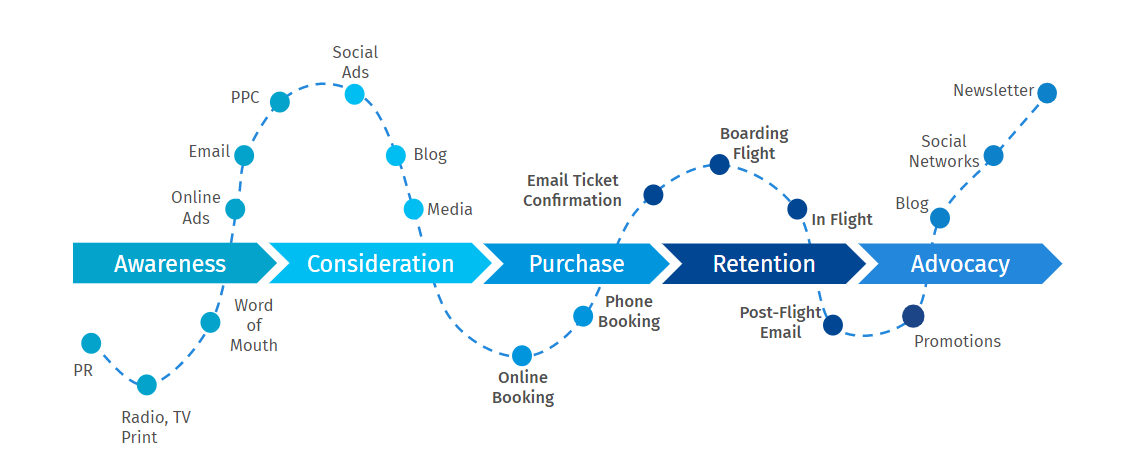Stories move the world, because for people to get moving, we need a reason, a “why”. But storytelling is not only a powerful tool for generating user engagement. Stories are a valuable source of knowledge for companies, when analyzing the behavior of their customers' journey.
When quantitative data falls short, because we have to analyze emotions, feelings or impressions (and you might find it hard to put those into numbers), it is necessary to have other tools that allow us to take a dive to what happens in our client's mind. A story by itself is not capable of achieving this, and for this reason, one of the most powerful storytelling tools is customer journey mapping.
What is Customer Journey Mapping?
Customer Journey Mapping is the process of charting your customer’s journey to have a visual representation of your customer’s touchpoints, feelings, and transactions with your brand.
By the time a customer decides to purchase a product or enroll in a service, they have already taken steps to seek solutions and weigh their options. To ensure you win and keep their business, you need a plan to stay relevant and top-of-mind at every junction on your ideal customer’s journey map.
The importance of Customer Journey Mapping
Mapping your customer journey is an action that needs to be well executed if you want your customer experience program to have a good solid foundation.
The deeper you dive into what type of experience is having your customer with your brand (and how it makes them feel), the better you know which touchpoints need to be improved throughout their journey.
For an organizational change to happen, the focus needs to shift to the customer – and that’s where customer journey mapping comes in.
So, what now? You now understand that Customer Journey Mapping is critical to building trust, engagement, and loyalty with new and returning customers.
But - where do you start and what elements do you need to take into consideration?
Key elements in Customer Journey Mapping
There are many ways to build a CX Journey Map; there are even companies that specialize in supporting organizations in better understanding the principles of journey mapping and provide in-depth consulting on the topic. It can also be a very simple process that focuses on one area of a business or channel.
Regardless of the approach, two common elements are:
Steps to follow. You should be left with a documented set of steps that the customer may take to interact with your brand.
Keep it up to date. Your customer journey map will never be static. Whether adding or subtracting your touchpoints, they will be changing. In other words, you and your team should always keep in mind the customer journey map needs regular updates.
When mapping your customer journey, you are looking at those defining moments in the interaction. Not every touchpoint necessarily needs a survey attached to it, but there should be some way of measuring success at that touchpoint.
For example, a customer on an e-commerce website will have opinions about the UX, the ease of finding products, and the check-out process – however, we wouldn’t necessarily ask them to document the processing time of the backend payment system and their satisfaction with the payments company.
How to do a Customer Journey Mapping?
If you want to put to test your customer journey mapping skills, you’ll need:
- Flip chart or a whiteboard
- Something to write with
- Mapping Foundation (Rational to emotional)
- Five to six colleagues
Using what you have above, begin mapping out current customer experience using post-it notes. After you have completed the mapping, have each member initial and affirm the touchpoints. Initials are a sign of validation and buy-in. Now that you have everyone’s initials, they have claimed ownership, and it becomes an artifact. The goal is to get everyone on the same page and agree.
Provide each member with five green sticker dots and five yellow sticker dots (or any kind of indicator). The green will represent pain points, and the yellow will represent the most critical touchpoint, or what we call a “moment of truth.” This is what makes or breaks a customer.
Once this is done, repeat this process with the next five to six people.
Now that you have all your sticker dots well-represented, you should be able to distinguish your moments of truth and pain points. For the identified moments of truth, make sure you have the correct metrics. These moments of truth are critical for everyone in the organization to be involved, starting with the front staff.
Learn more about how to create a customer journey map
Customer Journey Mapping Best Practices
Mapping your first customer journey can be a challenge. If you want to have the best outcome, the next tips could be worth following:
- Emotional outcomes. A critical component that you must not miss is the emotional essence of journey mapping. Part of the mapping process is about understanding the customer’s experience and the emotional goal of each stage. When you have your mapping, you will be able to review all current customer metrics to ensure they align with key areas for customers. Because the mapping is done on one sheet, you can see the end-to-end emotional journey of customers throughout the organization.
- Choose the right touchpoints. To map out the customer journey, start somewhere small. You could even start off with a pair of touchpoints. Ask yourself: is it just after you close a sale? 3 months after a sale? You should choose the most important touchpoints to start with. Remember the objective is to find the key points of interaction and define exactly the motivations that lead potential customers to move on to the next stage in the purchase process.
- Use a Customer Journey Mapping tool. Customer Journey Mapping tools are online platforms built to help you visually represent the journey that your customers take when interacting with your brand. Perhaps you work remotely and you rather do a customer journey map online to better collaborate with your colleagues.
- Customer journey maps are not static. Every customer is different. They’re people, just like you. Even the most reliable demographic data or carefully planned strategies will miss an occasional twist or turn on your customer journey map. That’s OK! You do not need to set these maps in stone. It’s vital to revisit them regularly and compare your strategy with real-life results. And above all, listen to your ideal customers.
Touchpoints: Critical in mapping you Customer Journey
Much like a road map, the CX Journey Map becomes more informative with increased detail - this is why you have to pay extra attention to touchpoints.
Imagine a sports franchise that would only be interested in taking a look at the touchpoints they could influence. Since they don’t manage parking or stadium concessions, they don’t see it as important to understand. However, the ability to change or impact the touchpoint is the entire reason to include it when mapping your customer journey.
With events, the spending decision is almost always made outside of the venue and goes beyond the events at the venue and even more than the day of the event. While looking at parking, stadium entry and entertainment value can be a guide to the event CX, a more detailed approach that includes the purchase decision (which can be influenced by past attendance, the current team record, and even weather) or getting there (who is going, the best way to make the journey and perhaps even having a meal before the event) can provide a deeper understanding of the experience even where you are unable to influence the outcomes.
Some of the roadblocks – both metaphorical and literal – can even be unexpected, but acknowledgment goes a long way in establishing a best-in-class CX measurement system.
How to get the most out of your Customer Journey Mapping
If your customer journey mapping is done as indicated in this article, you may have a higher chance to understand better your customer experience and how they feel about your product. Remember, the map should provide that information clearly and understandably because customer experience is a part of every role. As much as starting a journey with customers through a CX program is important, it is much more critical to know what roads to take to get to the destination, even if it is a long journey with many stops.
Read more about the customer journey canvas explained.
Customer Journey Mapping is a powerful tool to equip the front-line with the hard evidence that allows them to see the value they are providing to customers. It is also the most powerful mechanism to get everyone on the same page. From there, you can then add metrics to track your performance.
This is why mapping the perfect customer journey is key, prior to the deployment of your CX program. With QuestionPro CX - the best customer experience management platform in the market - you can boost your customers’ experience at every touchpoint and turn them into brand advocates. Gain valuable insights into your customers’ thoughts and emotions using QuestionPro CX today.
Take full control of your customer’s journey and make immediate business actions with SuiteCX by QuestionPro
SuiteCX by QuestionPro offers actionable data to help you manage customer experience. Take a live demo of the QuestionPro customer experience management platform and have a 360-degree view of your customers' interactions with your business.
Survey Software Easy to use and accessible for everyone. Design, send and analyze online surveys.
Research Suite A suite of enterprise-grade research tools for market research professionals.
Customer Experience Experiences change the world. Deliver the best with our CX management software.
Employee Experience Create the best employee experience and act on real-time data from end to end.





